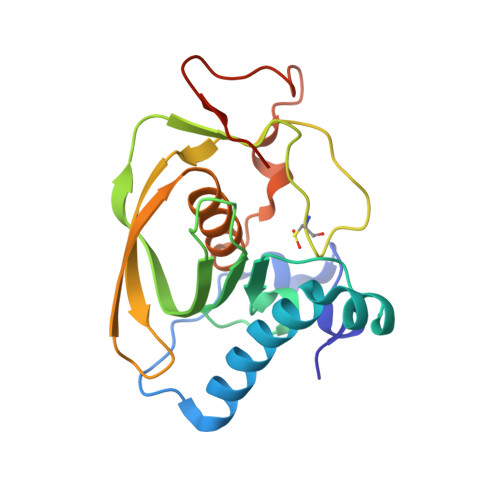Structures of Staphylococcus aureus peptide deformylase in complex with two classes of new inhibitors
Lee, S.J., Lee, S.-J., Lee, S.K., Yoon, H.-J., Lee, H.H., Kim, K.K., Lee, B.J., Lee, B.I., Suh, S.W.(2012) Acta Crystallogr D Biol Crystallogr 68: 784-793
- PubMed: 22751663
- DOI: https://doi.org/10.1107/S0907444912011912
- Primary Citation of Related Structures:
3U7K, 3U7L, 3U7M, 3U7N - PubMed Abstract:
Peptide deformylase (PDF) catalyzes the removal of the formyl group from the N-terminal methionine residue in newly synthesized polypeptides, which is an essential process in bacteria. Four new inhibitors of PDF that belong to two different classes, hydroxamate/pseudopeptide compounds [PMT387 (7a) and PMT497] and reverse-hydroxamate/nonpeptide compounds [PMT1039 (15e) and PMT1067], have been developed. These compounds inhibited the growth of several pathogens involved in respiratory-tract infections, such as Streptococcus pneumoniae, Moraxella catarrhalis and Haemophilus influenzae, and leading nosocomial pathogens such as Staphylococcus aureus and Klebsiella pneumoniae with a minimum inhibitory concentration (MIC) in the range 0.1-0.8 mg ml(-1). Interestingly, the reverse-hydroxamate/nonpeptide compounds showed a 250-fold higher antimicrobial activity towards S. aureus, although the four compounds showed similar K(i) values against S. aureus PDF enzymes, with K(i) values in the 11-85 nM range. To provide a structural basis for the discovery of additional PDF inhibitors, the crystal structures of S. aureus PDF in complex with the four inhibitors were determined at resolutions of 1.90-2.30 Å. The inhibitor-bound structures displayed distinct deviations depending on the inhibitor class. The distance between the Zn(2+) ion and the carbonyl O atom of the hydroxamate inhibitors (or the hydroxyl O atom of the reverse-hydroxamate inhibitors) appears to be correlated to S. aureus inhibition activity. The structural information reported in this study should aid in the discovery of new PDF inhibitors that can be used as novel antibacterial drugs.
- Biomolecular Function Research Branch, Division of Convergence Technology, Research Institute, National Cancer Center, Goyang, Gyeonggi 410-749, Republic of Korea.
Organizational Affiliation:



















